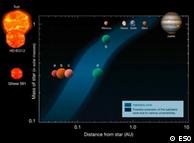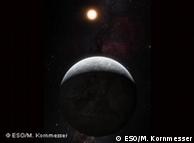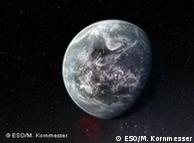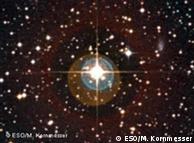SPACE | 13.09.2011
Earth-like planet sparks new hope for further life in universe
On Monday, European Southern Observatory (ESO) astronomers presented findings on a new, potentially habitable planet, known as HD 85512b, which is located 36 light-years away from Earth.
The planet is the second-ever to be discovered that falls within a "habitable zone" of an ideal distance from its nearest star.
The new finding brings the total of known exoplanets, or planets beyond our own solar system, to 677. Nearly all of these planets have been discovered in the last 30 years.
Despite the hopeful findings, which were presented at a conference in the United States, there is still quite a bit more research to be done before scientists can say that this planet can definitely support life.
 Even if a planet falls within the habitable zone, several other conditions are necessary for it to be able to sustain life'On the warm edge'
Even if a planet falls within the habitable zone, several other conditions are necessary for it to be able to sustain life'On the warm edge'The habitable zone for planets, based on known conditions on Earth, is determined by the relationship between the distance of a planet from its sun and the mass of the star it orbits.
The zone is where the surface temperature of the planet is likely to be between 0 and 100 degrees Celsius – a temperature that would allow for the existence of liquid water.
Within our own solar system, Venus, Earth and Mars fall within the habitable zone. But a number of other factors, including geological composition, also come into play where habitability is concerned.
Most importantly, scientists say, a planet must have an atmosphere.
"[Venus] is not habitable because of the greenhouse effect," explained Stephane Udry, director of the Geneva Observatory and one of the new findings' lead researchers. "The Earth would be -20 degrees [Celsius] if it had no atmosphere."
He added that the newly discovered planet is "on the warm edge of the habitable zone" – which lends more uncertainty to its potential for to support life.
Hans-Jörg Deeg, an a German astronomer based at the Institute for Astrophysics of the Canary Islands, and who did not take part in generating the new findings, said that although it's "very possible" that the new planet has an atmosphere, it also "could be too warm" to support life.
 Life on other planets could be very different from that on EarthMass known, radius sought
Life on other planets could be very different from that on EarthMass known, radius soughtThe ESO team working in Chile spent eight years probing the existence of the planet. Their research used an extremely precise spectrograph to observe the "wobble" in the gravity of the HD 85512 star – indicating that a planet is in orbit.
Based on the amount of wobble, the team was able to calculate the mass of the planet, which is about 3.6 times that of Earth.
The star it circles is also about two-thirds the size of our own sun, which would make life there heavier – and maybe dimmer – than it is on planet Earth.
Once the mass and radius of a planet are known, Udry explained, its density can be calculated, which is key for knowing about the presence of its atmosphere.
Udry said the next step is to get data on the planet's radius, which is typically done using a "transit method" of measuring how much light is hidden when the planet eclipses its star.
The chances of being aligned just right from Earth to see this, however, are low.
To see even the planet itself, "you'd need a big telescope in space," Udry said, which doesn't exist at this point.
The astronomers also found 16 planets with masses between that of Earth and Neptune.
"Some are big with a small mass, some are small with a big mass - there is a huge diversity," Udry said.
The findings will really open up the field of comparative exoplanetology, he noted.
The ESO team is examining tens of thousands of stars and through another project in the works, the researchers expect to eventually get density data on several dozen planets in the habitable zone.
"Now there's still the question of whether there's a planet in the middle – not too hot, not too cold," concluded Hans-Jörg Deeg, the German astronomer. "Sooner or later, we will find them."
Author: Sonya Angelica Diehn
Editor: Cyrus Farivar
Editor: Cyrus Farivar
dw



No comments:
Post a Comment